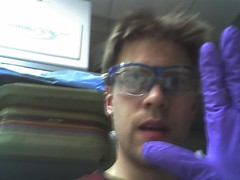How To Teach Science: Linkblogging
Time Magazine: Looking for a Lab-Coat Idol:
A teacher must feel confident in the subject to veer from the rote learning that turns so many students off. At Frick Middle School in Oakland, Calif., science teacher Caleb Cheung turned seventh-graders into inquisitive crime-scene investigators when he introduced a unit last fall on cells and microscopes. Students arrived in class to find an empty birdcage and a ransom note--someone had apparently kidnapped Cheung's pet doves, Herbert and Angel. For the next six weeks, the young detectives analyzed fingerprints, interviewed witnesses and compared hair and fabric samples under microscopes to find the perpetrator.
(Via Aetiology)
Zygote Games: Where Fun Begins!
BONE WARS: The Game of Ruthless Paleontology
Out in the field, fossil hunters must survive natural disasters and attempts by other players to steal and destroy dinosaur bones.
Back at the museum, the conflict continues when the scientists carry their battle to the newspapers and scientific journals as they race to achieve scientific immortality!
(Via the next link)
Carl Zimmer: Movie Night
I talked about how my own experience as a science writer certainly meshed with some of Olson's own experiences. I can remember getting into discussions with biologists five or six years ago about the rise of intelligent design, and they would just give me blank stares. When I explained what was happening beyond their lab, most of them seemed to assume that I could only be talking about ten or eleven people very far away. Once intelligent design began popping up in newspapers and magazines and education standards, the biologists did perk up and take notice. But their responses were not quite up to the challenge. I recounted how a bunch of representatives from a lot of scientific societies gathered for a meeting on challenges to evolution and came away a clarion call to action: each society would post a statement in support of evolution on their society's web site. Other biologists didn't even think it was their place to get involved. If not them, I wondered, who?
WorldChanging: Biology Direct:
The growing acceptance of the "open access" scientific publishing model has made possible further experiments in the world of academic literatures. Open access publication makes scientific work available at no cost, in order to further the spread of knowledge and ideas among communities -- such as scientists in the developing world -- often locked out of cutting-edge science due to limited resources. The non-profit Public Library of Science (PLoS) journals are perhaps the best-known open access effort, but now BioMed Central -- which had sought to combine open access with commercial publication -- has embarked on an arguably even more radical experiment. Biology Direct, a newly-launched series of biology journals, combines the open access model with a new, and very open, system of peer review (PDF): the reviews are published alongside the articles, with no anonymity -- and no rejection, even if the reviews are uniformly negative. (The author may choose to pull his or her article in such a case, of course.)


0 Comments:
Post a Comment
Send Haloscan trackback ping
<< Home